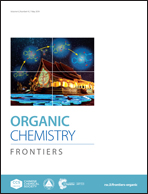Synthesis of an open-cage fullerene-based unidirectional H-bonding network and its coordination with titanium†
Abstract
Open-cage fullerene derivatives with up to three hydroxyl groups on the rim of an orifice were prepared through modification of functional groups followed by controlled stepwise reduction of carbonyl groups on the rim. The hydroxyl groups form a unidirectional H-bond network and show a weak but clear interaction with a water molecule trapped inside the fullerene cage. Titanium ions coordinated with the hydroxyl and carbonyl groups to form a TiL2 type of complex.



 Please wait while we load your content...
Please wait while we load your content...